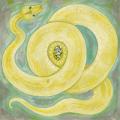» Site Navigation

0 members and 1,088 guests
No Members online
Most users ever online was 47,180, 07-16-2025 at 05:30 PM.
» Today's Birthdays

» Stats

Members: 75,916
Threads: 249,118
Posts: 2,572,202
Top Poster: JLC (31,651)
|
-
Registered User


The Remarkably Diverse Diets of Wild Ball Pythons
Let's talk about the opportunistic nature of wild ball pythons! This isn't new news by any means – I've seen this study referenced on here a couple of times. But it's also not discussed a whole lot, and I'm sure a few of you would find it interesting if you're unfamiliar.
In 1998, researchers captured a few dozen ball pythons in southeastern Nigeria and analyzed the contents of their stomachs. The snakes had preyed exclusively on mammals and birds with some surprising results:
...the males preyed more frequently upon birds (70.2% of the total number of prey items) than upon mammals (29.8% of the total number of prey items), whereas the females preyed more frequently upon mammals (66.7% of the total number of prey items) than upon birds (33.3% of the total number of prey items). There was an apparent ontogenetic change in the diet of both sexes: specimens shorter than 70 cm total length preyed almost exclusively upon small-sized birds (nestlings and immature), whereas the longer specimens (> 100 cm total length) preyed almost entirely upon small mammals.
Mammals consumed include a variety of rodents as well as bushbabies and bats! Birds include pigeons/doves, immature african grey parrots, starlings and bee-eaters, among others.
Male pythons were found climbing trees more frequently than females (14 males vs 2 females), which is reflected in the types of prey more frequently consumed. One theory is that this allows males and females to occupy different ecological niches and avoid competing with one another.
The article concludes with this:
With regard to the prey eaten by royal pythons, it may be noted that all the mammalian species, except Galagoides demidoff, are widespread and relatively abundant in the forest ecosystems of the studied region (Angelici, unpublished data). Thus, it is likely that opportunism represents an intrinsic trait of the predatory behaviour of these snakes.
Certainly opportunistic eating isn't a quality often associated with ball pythons!
The full study can be accessed here: http://www.tandfonline.com/doi/abs/1...4#.VZykCkaYpLM
The research took place primarily during the wet season. Curious if these numbers would vary seasonally or regionally.
So this begs the question: do you think there's any advantage in trying to mimic these variations in diet in captivity? Obviously feeding lean wild fledglings isn't really an option, but would there be any nutritional benefit to adding chicks or quails to the roster?
Last edited by Snake Judy; 07-08-2015 at 03:22 AM.
Reason: formatting
-
The Following 3 Users Say Thank You to Snake Judy For This Useful Post:
anicatgirl (07-08-2015),scalrtn (07-08-2015),The Golem (07-08-2015)
-
Interesting findings, thank you for sharing.
I have read here more than a few times of folks feeding or having intentions to feed chicks to their BP's.
Now it is not uncommon at all for some of the Boa owners to feed quail and rabbits as a variety to the rat diet on hand.
The one thing I found that you can count on about Balls is that they are consistent about their inconsistentcy.
1.2 Coastal Carpet Pythons
Mack The Knife, 2013
Lizzy, 2010
Etta, 2013
1.1 Jungle Carpet Pythons
Esmarelda , 2014
Sundance, 2012
2.0 Common BI Boas, Punch, 2005; Butch, age?
0.1 Normal Ball Python, Elvira, 2001
0.1 Olive (Aussie) Python, Olivia, 2017
Please excuse the spelling in my posts. Auto-Correct is my worst enema.
-
-
Re: The Remarkably Diverse Diets of Wild Ball Pythons
I think the variety of prey items is the key in part to a healthier captive animal. And chicks , even though they are mostly feathers they are higher in protein content than rats or mice. So the occasional chick certainly has its place in the diet. Live or f/t. Thanks for that. 
 Stay in peace and not pieces.
-
-
Registered User


Re: The Remarkably Diverse Diets of Wild Ball Pythons
Thanks for the link! I'm very new so I hadn't seen this information at all. My BP is rather small so it'll be a while before he could eat even the tiniest of chicks, but it seems to me that variety in the diet can only be a good thing.
1 Normal BP - Professor Snape
2 Sugar Gliders - Lucy & Ethel
3 Finches - Hook, Smee & Scully
1 Chinese Dwarf Hamster - Master Splinter
-
 Posting Permissions
Posting Permissions
- You may not post new threads
- You may not post replies
- You may not post attachments
- You may not edit your posts
-
Forum Rules
|








 Reply With Quote
Reply With Quote

 Stay in peace and not pieces.
Stay in peace and not pieces.